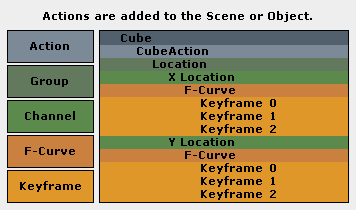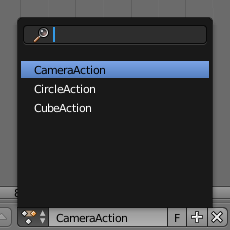Actions¶
When animating objects and properties in Blender, Actions record and contain the data. As everything else in Blender, Actions are data-blocks.

Actions.
So when you animate an object by changing its location with keyframes, the animation is saved to the Action.
Each property has a channel which it is recorded to, for example, Cube.location.x is recorded to Channel X Location. The X location and Y location properties can be shared across multiple objects, if all objects have X location and Y location properties beneath them.

Graph Editor. Each Channel has an F-Curve represented by the lines between the keyframes.
- Actions
- Record and contain animation data.
- Groups
- Are groups of channels.
- Channels
- Record properties.
- F-Curves
- F-Curves are used to interpolate the difference between the keyframes.
- Keyframes
- Keyframes are used to set the values of properties bound to a point in time.
Working with Actions¶

The Action data-block menu.
When you first animate an object by adding keyframes, Blender creates an Action to record the data.
Actions can be managed with the Action data-block menu in the Dope Sheet Action Editor header, or the Properties region of the NLA Editor.
If you are making multiple actions for the same object, press the F button for each action, this will give the actions a Fake User and will make Blender save the unlinked actions.
Objects can only use one Action at a time for editing. The NLA Editor is used to blend multiple actions together.
Bake Action¶
Reference
| Editor: | 3D View |
|---|---|
| Mode: | Object and Pose Modes |
| Panel: | |
| Menu: |
The Bake Action tool will apply interpolated frames into individual keyframes. This can be useful for adding deviation to a cyclic action like a walk cycle. This can also useful for keyframe animations created from drivers or constraints.